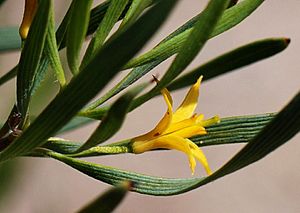Persoonia quinquenervis facts for kids
Quick facts for kids Persoonia quinquenervis |
|
|---|---|
 |
|
| Scientific classification | |
| Genus: |
Persoonia
|
| Species: |
quinquenervis
|
| Synonyms | |
|
|
Persoonia quinquenervis is a special type of flowering plant. It belongs to the Proteaceae family, which has many unique plants. This plant is found only in the south-west part of Western Australia. This means it is endemic to that area. It's a shrub that grows upright and spreads out. Its young branches are a bit hairy. The leaves are long and narrow, sometimes twisted. When it blooms, it has bright yellow flowers. These flowers grow in groups of up to ten on a central stem called a rachis. This stem keeps growing even after the flowers open.
Contents
What This Plant Looks Like
Persoonia quinquenervis is a shrub that stands tall and spreads out. It usually grows between 0.2 and 2.5 meters (about 8 inches to 8 feet) high. Its bark is smooth, but sometimes it can be rough or peel off near the bottom. The young branches are covered with soft, grayish or whitish hairs for a year or two.
The leaves of this plant are quite interesting. They are long and narrow, like a line or a small spear. Some are shaped like a narrow rectangle or a small spatula. They are often twisted at their base. These leaves are usually 20 to 75 millimeters (about 0.8 to 3 inches) long. They are also 0.8 to 10 millimeters (about 0.03 to 0.4 inches) wide. You can often see thin lines or ridges running along both sides of the leaves.
The bright yellow flowers grow in groups. Up to ten flowers can be found along a stem called a rachis. This rachis can be up to 60 millimeters (about 2.4 inches) long. What's cool is that this stem keeps growing even after the flowers bloom! Each flower sits on its own small stalk, called a pedicel, which is 4 to 17 millimeters (about 0.16 to 0.67 inches) long. At the base of each pedicel, there's a small leaf or scale. The flower parts, called tepals, are bright yellow and 7.5 to 15 millimeters (about 0.3 to 0.6 inches) long.
This plant mostly flowers from November to December. After flowering, it produces a smooth, oval-shaped fruit. This fruit is a type of drupe, similar to a small plum. It is 8 to 12 millimeters (about 0.3 to 0.5 inches) long and 4 to 6 millimeters (about 0.16 to 0.24 inches) wide.
How This Plant Got Its Name
The scientific name Persoonia quinquenervis was first officially given in 1842. This was done by a botanist named William Jackson Hooker. He described the plant in his book Icones Plantarum. The plants he studied were collected in the Swan River Colony by James Drummond.
Where This Plant Lives
This type of geebung (another name for Persoonia) grows in several different kinds of environments. You can find it in areas with heath, thickets, woodlands, and forests. It lives in the south-west of Western Australia.
The areas where it grows include places like Latham, Boyagin Nature Reserve, Tarin Rock, Frank Hann National Park, and Yellowdine. These locations are part of different natural regions. These regions are called the Avon Wheatbelt, Coolgardie, Esperance Plains, Geraldton Sandplains, Jarrah Forest, Mallee, and Swan Coastal Plain.
Conservation Status
The Government of Western Australia's Department of Parks and Wildlife has looked at the status of Persoonia quinquenervis. They have classified it as "not threatened." This means that, for now, there are enough of these plants, and they are not in danger of disappearing.

